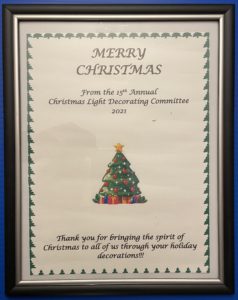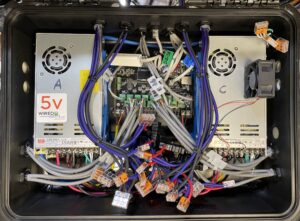These are some commonly asked questions about our show, and shows like it. If you want more technical information- please visit Wolf’s blog at:
https://lunardenlights.com
Q: Why does the sound seem to be way off on my car radio?
A: Some car radios don’t actually give you “live” audio from radio stations. Click here for more information.
Q: How did you get a radio station to play your music?
A: We use a low-power FM radio transmitter, not a commercial radio station. They are often used by drive-in movie theaters/events and by churches to broadcast services to their parking lots (especially during COVID-19). Ours has a practical range of a couple of blocks.

Q: Why don’t you stream your music? Isn’t FM radio a bit old-school?
A: Because of Internet, cellular data lag, and other networking and processing delays, streamed audio isn’t actually “live”, and is delayed by a variable number of seconds. It can be delayed by 1-5 seconds or more, and there is no consistency with that timing. It is just not possible to stream a live performance like ours because of this.
UPDATE 2024: There are some companies that have introduced streaming systems that synchronize our show with their own streaming servers using proprietary technologies. Two of note are Tune2 and PulseMesh. We have tested both and are currently using PulseMesh of our show. See our Stream Us! page for more info. Right now they are in testing and are close but still not quite as good as FM radio. We expect them to improve during and after this holiday season.
Q: What’s a pixel?
A: While there are other definitions, in the case of a light show like ours- a pixel is a small light bulb that contains 3 tiny LEDs (Light Emitting Diodes). The three LEDs are three different colors, Red, Green, and Blue, which are often just referred to as “RGB”. By varying the brightness of each LED- a pixel can (theoretically) display over 16 million colors. These colors can be changed dozens of times every second, allowing us to use thousands of them to display special effects synchronized to music.
Q: Don’t you have a huge electric bill doing this?
A: No, we don’t at all. We use a power management system to track all of our show’s power needs. In 2022 our light show used a maximum of about 500W when most of the LEDs are lit up brightly. The controller computers and other electronics use very little power, and the pixels only use power when they are actually lit up. One of the projectors we use for displaying video and “virtual matrix” elements uses more power than all of the LED pixels combined.
In 2021 I miscalculated our cost ($12) as I had the wrong per-kWh cost from our utility. With Ameren’s tiered Winter rates, we actually spent about $9 for power then. In 2022, we used $15 worth of electricity. We are adding another projector and at least 2000 more pixels for 2023, so I expect we may come close to $25! 😀

Q: How do you do make the lights play to the music?
A: It’s pretty involved, but in a nutshell:
We use special software called xLights to digitize all of our display elements (decorations) on a 3D plot. We can then load music into it and map different elements of the music, like beat, melody, different instruments, and lyrics, to special effects on those display elements. Once this programming is completed, the “Sequence” is saved. In many cases- we buy sequences from vendors and then adapt them to our own show, which saves us countless hours of programming time.

Once the sequences are done- they are uploaded to the computer and controller network that actually controls all of the lights. These all run software called FalconPlayer or FPP. A Show Runner computer manages the music, sequence library and playlists, and has a scheduling system. It coordinates with the other controllers to make all the lights blink to the music when they are supposed to.

Q: Don’t you upset your neighbors doing this?
A: Well, so far we don’t think so. We talk to our neighbors next door and across the street and they love the show and have been very supportive.
The biggest thing that upsets folks in the neighborhood isn’t the lights themselves, it’s cars stopping in the middle of the street or blocking their driveways, or folks with their windows rolled down blaring the music. Please don’t do this. Also, when you stop, please turn your headlights off so they aren’t shining in windows or blinding other people trying to drive by or watch the show.
Q: Have you won any awards? Have you seen “The Great Christmas Light Fight?”
A: Yes and yes. These always seem to go together. First and foremost though- we aren’t in this for awards or competition. We are in this for our own enjoyment, and to provide something that we hope our community enjoys too. We have won a few local awards (Thank you!), and really have no interest in competition/reality shows like The Great Christmas Light Fight.
What really makes us happy is seeing more people in our neighborhood and community putting up Christmas lights and getting into the holiday spirit. For a long time- people just weren’t decorating anymore, and there has been a surge over the last few years that we are happy to be a part of.

Q: Are there other shows like yours around here?
A: Yes- there are at least two that we know of.
Please see our “Must See” Christmas Lights in the Cape Girardeau area list.
Q: Can I just buy a light show like this at Menards, Home Depot, Lowes, or Amazon?
A: No. (!)
There are no “plug-and-play” light shows like this that you can just buy, set up, and walk away from. Our show is made up of over 200 DIY and commercially-sourced props/decorations, dozens of computer, network, and controller components, hundreds of feet of power, network, and data cables, and of course- thousands of individually-addressed pixel nodes and matrix panel LEDs. It takes both of us hundreds of hours each year to prepare and set up, and it requires daily maintenance to keep running during the season. Each musical light sequence can take many hours or even days to program.
We love doing it, but have also seen a lot of people jump into this hobby and quickly get frustrated and give up, after spending a LOT of time and money.
In 2021 we and others in this hobby noticed a lot of fly-by-night (Chinese) companies claiming to sell complete “light shows” online, especially on Facebook. Some have even stolen video from real shows like ours, claiming they can do the same thing for under a hundred dollars. They can’t. Please don’t waste your money. There are some legitimate online sellers of pre-built controller boxes and custom pixel strings, but beyond that- this is still a very-DIY hobby, with limited or no real “support” other than online forums and videos.
You can buy systems from companies like Light-O-Rama. They still require a significant amount of work and can be very expensive. They used to only deal in “AC” systems, allowing you to turn conventional Christmas lights on and off to music, but more-recently started selling RGB pixel systems. Light-O-Rama’s gear is frequently used for commercial installations.
If you want more information about running a show like this, Wolf’s tech blog at https://lunardenlights.com has a lot more information, including resources and terminology links. A background in electronics and computers, or an aptitude and strong desire to learn, is a must!
A related question that is often asked is “How much did all of this cost?”. We haven’t kept careful track, and don’t really want to. It’s a hobby after-all! I will say that if you really want to do this, you can count on spending more than $1000-2000/year as you grow your show, and hundreds of dollars every year just on maintenance. Post-COVID-19 things got a lot more expensive too. Of course it gets significantly more expensive if you want to buy pre-built everything and have someone else do most of the work for you, and costs much less if you DIY most of it.

Q: Is there someone we can just pay to do this for us? How about you?
A: We have “day jobs” and just doing our own show takes up a significant amount of our spare time throughout the year. There are some folks who have made a business out of doing this and do full installs, mostly for commercial and municipal projects. They are in larger cities though. Unfortunately as far as we know there is nobody in this area (Southeast Missouri) that does them.
You can get professionally installed light displays (house outlines that don’t sync to music) for home or commercial buildings through companies like trimlight.com. For those local, check out https://www.facebook.com/trimlightsemo.
Some local landscaping companies do some really outstanding conventional Christmas light installs, which are a good option if you can’t devote time to a pixel light show. As far as we are concerned- any lights are better than none!
